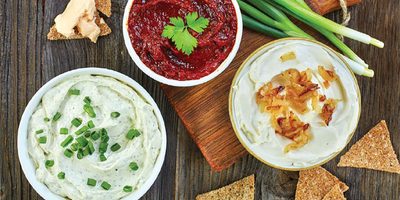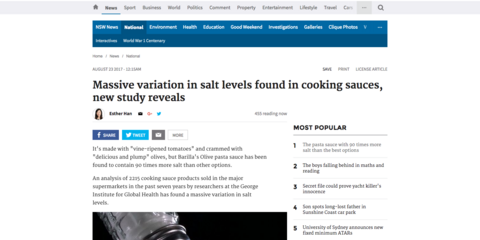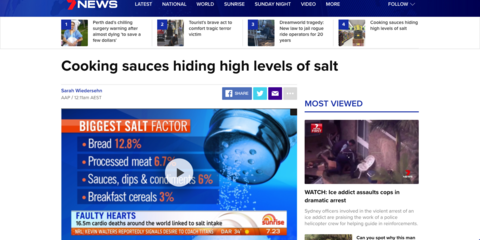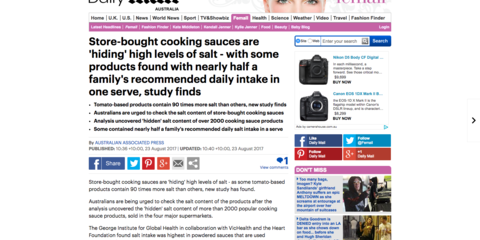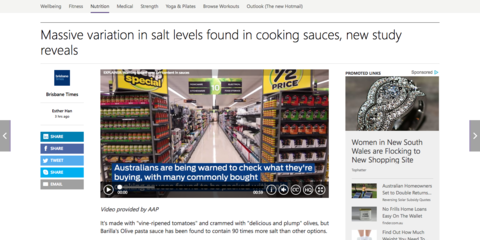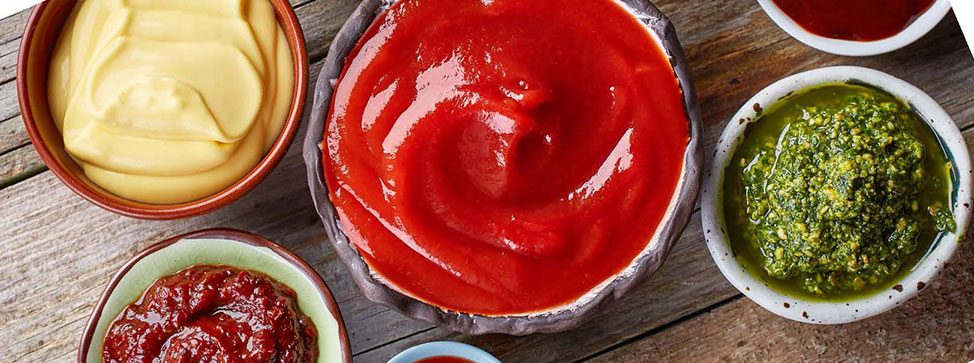
New research shows family favourite cooking sauces are packed with salt
Download the full report "Changes in salt levels in cooking sauces, Australia, 2010-17" (PDF 663KB)
Download the table of results of salt in cooking sauces (PDF 278KB)
Convenience cooking sauces may be quick and easy but come at a high cost to health, according to new research1 released today by The George Institute for Global Health, VicHealth and the Heart Foundation.
Researchers analysed 2215 cooking sauce products sold in four major supermarkets (Coles, Woolworths, ALDI and IGA) from 2010-2017 and found they have one big problem in common - they're packed with salt, with some brands nearly 100 times worse than others.
The results were released today to mark the launch of Unpack the Salt – a new consumer awareness campaign led by the Heart Foundation – urging Australians to be aware of hidden salt in packaged foods.
The report found the pasta sauces, Indian and Asian-style pastes, refrigerated and powdered recipe-based sauces such as casserole and curry mixes that we throw into meals are pushing us over the maximum daily salt intake of five grams recommended by the World Health Organization. Australians currently eat nearly double that amount each day, with 75 per cent of it coming from packaged foods.
Key findings:
- There was a massive difference in the amount of salt between brands for tomato based pasta sauces, with some containing 90 times more salt than others2
- Barilla Olive pasta sauce stood out for its high salt content (1.88g salt/100g), 90 times saltier than Tenuta Fragassi Sugo Pronto Napoletana Neapolitan Style Pasta Sauce (0.02g salt/100g)
- Salt content was highest in powdered sauces that are used as a component of meals such as casseroles, curries and pasta bakes, where salt targets weren’t imposed on food manufacturers. Some contained almost half a family’s recommended daily salt intake in one serve alone3
- For powdered sauces, McCormick Garlic & Rosemary Lamb Shanks topped the list with 22.38 grams of salt per 100 grams compared with Maggi Tomato & Onion Sausages (1.79g salt/100g), which had the least amount of salt
- On average, salt content of ambient meal-based sauces (shelf-stable sauces found in the unrefrigerated supermarket aisles) increased by 29% from 2010-2017, with Asian/black bean sauces the highest (2.37g salt/100g)
- Curry pastes also contained high levels of salt, with some containing 20 times more salt than others4
- McCormicks powder-based sauces were found to have the highest salt content of all cooking sauces, and Tenuta Fragassi tomato-based cooking sauces the least.
The George Institute’s Public Health Nutritionist Clare Farrand said the report showed excessive levels of salt in cooking sauces, and huge variation in salt levels from product to product, put consumers’ health at risk.
“A fresh pasta sauce from the supermarket refrigerator contains almost a third of a daily salt intake in the sauce alone5 - add cheese and you could be blowing the family’s salt intake to well over the maximum daily limit,” Ms Farrand said.
Ms Farrand added: “While powdered mixes are used to make up a meal, and are often shared between a family - many people don’t realise just how salty they are. The best advice is to check the label and try and choose the lower salt option, or better still – make your own – with far less salt.’
Heart Foundation Victoria CEO Kellie-Ann Jolly said the link between a high salt diet and high blood pressure is clear-cut, leading to an increased risk of heart disease.
“High blood pressure causes 32 per cent of heart disease and stroke in Australia and currently, there are close to six million adult Australians living with high blood pressure – that’s over a third of our adult population,” Ms Jolly said.
“When you cook with some of these packaged sauces, you’re eating way more than the recommended amount of salt per serving. This is alarming given we need to be encouraging people to eat less salt, not more.”
Ms Jolly added that in good news the research revealed some progress, with manufacturers reducing the amount of salt in pasta sauces by 27 per cent from 2010-2017, in line with salt targets.
“While we have seen salt levels drop in some sauces, the huge variation shows that manufacturers can produce lower salt products and reminds us that there is much more work to be done.”
VicHealth CEO Jerril Rechter said alarming levels of hidden salt in packaged foods led the Victorian Salt Reduction Partnership to launch Unpack the Salt: “It’s critical we raise awareness of the dangers of hidden salt in packaged foods to help consumers make the healthy choice for their families,” she said.
Ms Rechter encouraged people to use the resources at Unpack the Salt to make better decisions about their health.
Tips for consumers
- Visit unpackthesalt.com.au for more information about the campaign and for tips and resources on how to identify salt in packaged foods and reduce your salt intake
- Sodium is one component of salt - it is the sodium that is labelled on nutrition information panels on packaged foods
- To reduce salt in your diet and for your family, it’s important to know how to check the amount of sodium listed on packaged foods. Use the ‘per 100g’ column to compare the sodium content of different brands
- For cooking sauces, look at the label and aim for less than 400mg sodium per 100g
- When using packaged sauces from the supermarket, try using less – for example, use only half of the packet or jar to reduce the amount of salt you will eat. You can always top up with extra herbs, and vegetables
- The best way to reduce salt is to eat more fresh foods and reduce your reliance on processed and packaged foods
- You can download the FoodSwitch app, which allows you to scan the barcode on packaged food products to find out the sodium content of the product. It will also give you options for healthier alternatives
- The Heart Foundation has a sodium and salt converter that easily allows you to convert the sodium listed on packaged foods into grams of salt, or vice versa
1 "Changes in salt levels in cooking sauces, Australia (2010-2017) report" by The George Institute for Global Health and VicHealth
2 Tomato based pasta sauces ranged in salt content from 0.02g to 1.88g salt per 100g (8-750mg sodium/100g)
3 Keen's Mustard Honey Mustard Chicken contains 2.12g salt/serve. Recommended salt maximum intake is 5g/day
4 Curry pastes ranged in salt content from 0.63g to 11.33g salt per 100g (251-4530mg sodium/100g)



